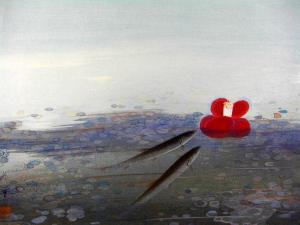Japanese Art and the intriguing nature of Hayami: Northern Renaissance to Bunjinga
Lee Jay Walker
Modern Tokyo Times

The artist Gyoshu Hayami (1894-1935) was born in the Meiji era whereby Japan entered a period of rapid modernization. However, his art belongs to the Taisho and Showa periods of Japanese history because he was too young to make a major impact in the Meiji era. Gyoshu Hayami was clearly influenced by the momentous events that were taking place in Japan. This can clearly be seen by his constant inquisitiveness and openness to new ideas. Despite this, the history of the past also remained firmly within his soul because he studied the styles of Yamato-e, Rimpa, and Bunjinga.
By the time Gyoshu Hayami had reached 17 years of age, it was abundantly clear that he was blessed with enormous talent. He was born in Tokyo and during his apprentice period, he studied under Matsumoto Fuko. When he reached 17 years of age Imamura Shiko invited Gyoshu Hayami to join the Kojikai circle. This artistic circle was focused on bringing together the cream of the crop of young artists. Also, because of the youthful nature of this circle, then areas of idealism and freshness will have filled the air naturally.

However, the winds of youth alongside the changes of time meant that the Kojikai circle was soon disbanded. Despite this reality, relations developed during this brief period. Hence, this circle was an important stepping-stone.
The artistic influence of Gyoshu Hayami is also very fascinating because it is extremely varied. Also, it is like looking at “a mirror” because much of his influence came from China and Europe. However, the richness of Japanese art ran throughout the veins of Gyoshu Hayami. Therefore, the fusions of influence and ideas enabled this “searcher” to grow throughout his short life.
He was charmed by the Chinese Song era (960-1279) and Yuan (1279-1368) periods whereby both impacted deeply on Japan. Indeed, it is remarkable to know that Sesshu Toyo (1420-1506) and Gyoshu Hayami share a similar fascination with the Chinese Song period.

Gyoshu Hayami was also influenced by the Northern Renaissance art movement therefore throughout his life he was always searching and challenging himself in order to learn new artistic concepts. However, the Yamato-e, Rimpa, and Bunjinga styles of art always stayed within his soul irrespective of later influences in his life. Indeed, in his later artwork you can also see a move towards Symbolism but despite this, the richness of the past remained deep within his psyche.
It is often said that the style of his art represents the aesthetics of Japan. This applies to the poetic nature of his art and the rich feeling of sensitivity. Therefore, irrespective if Gyoshu Hayami searched deeply into philosophy or not his art does represent the rich undercurrents of the aesthetics of the finer elements of Japanese high culture.
Sadly, Gyoshu Hayami died at a young age because illness ended his life suddenly in 1935. His death happened because of typhoid fever. Therefore, individuals can only imagine what he would have achieved in his later life because of the inquisitiveness nature that he had.

Modern Tokyo News is part of the Modern Tokyo Times group
DONATIONS to SUPPORT MODERN TOKYO TIMES – please pay PayPal and DONATE to sawakoart@gmail.com
http://moderntokyotimes.com Modern Tokyo Times – International News and Japan News
http://sawakoart.com – Sawako Utsumi personal website and Modern Tokyo Times artist
https://moderntokyonews.com Modern Tokyo News – Tokyo News and International News
http://global-security-news.com Global Security News – Geopolitics and Terrorism
PLEASE JOIN ON TWITTER
https://twitter.com/MTT_News Modern Tokyo Times
PLEASE JOIN ON FACEBOOK